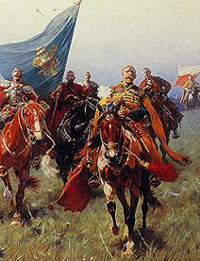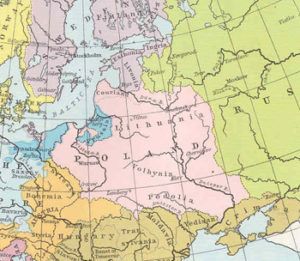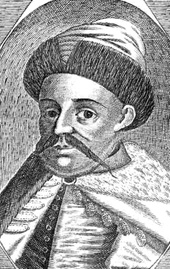
Jerzy (George) Niemirycz (1612-1659) was an ambitious Arian nobleman and statesman in the Polish-Lithuanian Commonwealth. During his later life the Commonwealth, which included the Ukraine, was nearly destroyed by Cossack revolt and Russian and Swedish invasion (a disastrous period in Polish history known as “The Deluge”). Niemirycz struggled in vain to protect religious liberties within the Commonwealth and to prevent the loss of the Ukraine to Russia. He designed a new Polish union that he hoped might withstand pressure from surrounding states. Because he changed national allegiances several times to further his goals and, in his last year, changed his religious faith for political advantage, he has an equivocal reputation in both Polish and Unitarian history. He is probably the most influential Unitarian in Polish history.
Jerzy was the eldest son of Stefan Niemirycz (d.1630) and Maria Wojnarowska (d.1632), devout Arian nobles living in the southeast region of Poland (now Ukraine). After receiving home tutoring he was enrolled at the Arian Academy of Raków (Racovia). Such was his talent for mathematics that one of his tutors, Joachim Stegmann, encouraged him to pursue it further. As the eldest son of a nobleman, however, his future lay in politics.
After completing his studies at the Raków Academy, in 1630 he left with a group of Arian nobles to be educated in Western Europe. He first studied at the University of Leiden in the Netherlands. There he met Krzysztof Arciszewski, a fellow Pole employed as a Dutch commander of the West India Company. Arciszewski had grown up Arian but had joined the Reformed Church in the Netherlands, reserving the right to his own opinion on the doctrine of the Trinity. He tried unsuccessfully to persuade Niemirycz and other Poles to start an Arian colony in Brazil. Niemirycz toured in France, England, Italy and Switzerland, 1632-33, before returning to Leiden. During his stay abroad he showed a keen interest in global politics, as evidenced by his Discursus de bello Moscovitico (Discourse on the Muscovite War), 1632, dedicated to his uncle Roman Hojski. In this he described the geopolitical situation of the current Polish-Muscovy War, 1632-34, fought over possession of the Russian city of Smolensk.
On his return to Poland in 1634, Niemirycz fought in the victorious campaigns against the Russians and, in 1635, against the Swedes, whose military power had been eroded by the Thirty Years’ War. Favorable treaties having been signed with Russia and Sweden, the Polish-Lithuanian Commonwealth entered a short period of peace and prosperity.
With a political career in mind, Niemirycz started to look for a wife. He considered marriage to a Roman Catholic, but in 1635/36, to the delight of Polish Brethren officials, he married the Calvinist Elzbieta Slupecka, who gave him valuable family connections to Protestant magnate families such as the Leszczynskis, Firleys and Potockis. In 1636 the Kijów nobility elected him a deputy judge to the Polish Supreme Court (Trybunal Koronny) in Lublin, where he presided over an Arian-Roman Catholic theological disputation between Krzysztof Lubieniecki and the Jesuit Kasper Druzbicki. His performance as judge must have pleased the nobility, for in 1637 they elected him member of parliament from that region, a post to which they returned him for many years.
During the first decade of his political career Niemirycz concentrated on defending the Polish Brethren from growing Catholic intolerance. In 1638 he tried in vain to stop Parliamentary proceedings against the Raków Academy. When it was ordered closed he signed a legal protest against the judgment. He was also one of the petitioners of the 1638 Kisielin gathering which wrote to the Calvinist duke Krzysztof II Radziwill, requesting aid and protection for the Polish Brethren.

Niemirycz maintained the Arian church in Czernichów founded by his father and grandmother, where the ministers were Piotr Stoinski (1610-1649) and Jerzy Ciachowski (1652-1661/62). He also established and supported an Arian church in Uszomir, where he founded a school and put the Dutch refugee Izaac Volger in charge. In 1643, after acquiring extensive lands south of Kiev on the eastern bank of the Dnieper River, he installed Andrzej Wiszowaty as minister there, that he “might preach the Gospel to Scythians and other peoples, following Saint Andrew.” Niemirycz employed many Unitarians, encouraged them to settle on his estates, and recommended them to other magnates, including tolerant Roman Catholics. His wealth allowed him to become a patron of the denomination. Numerous books and tracts were dedicated to him. He also enjoyed holding theological disputations among Arians, Catholics, and even the Orthodox.
In the late 1630s and 1640s Niemirycz enhanced his family fortune, which had the effect of supporting the Polish Brethren. He managed all of the family estates until 1648 when his brothers received their portions. Jerzy chose Horoszki as his seat. Through acquisitions and donations his possessions grew to include 14 cities and 50 villages with 7600 serfs. By 1648 he ruled the second largest domain in the Ukraine. The ways in which he acquired new estates were not always peaceful and legal. For example, in 1640, following the death of his aunt Aleksandra Hojska, he and his brothers raided and pillaged Hoszcza, at the same time reintroducing the Arians expelled from that city earlier. In the next years he attacked the estates of his cousins; in 1650 he was raided in turn by his own brother.
Despite being chosen as a member for nearly every parliament held, Niemirycz’s political fortunes did not prosper. In 1641, when he was chosen chamberlain of Kiev (podkomorzy kijowski), his Roman Catholic friend and protector Stanislaw Koniecpolski said that he might have been nominated to the Senate “if his faith did not stand in the way.” On this occasion, in his Arian pride, Niemirycz went too far. When about to be installed as chamberlain, he was asked if he was ready to swear by the Trinity. He replied that he would swear not only by a Holy Three, but also, if needed, by Four. This witticism led to a lawsuit for blasphemy that dragged on for years before it was quashed in 1645 by his relative, Andrzej Leszczynski, and the Roman Catholic bishop of Kijów. This episode did not endear Niemirycz to the Roman Catholic nobility. In 1646 the Supreme Court ordered him to close down all the Arian churches in his estates, to expel his fellow Brethren, and to pay a fine of 10,000 zlotys. Like other Arians, he ignored the ruling.

In 1648 the outbreak of the Cossack Revolt under Bohdan Chmielnicki signaled the beginning of the end for the Polish-Lithuanian Commonwealth. The Cossacks, many of whom descended from people who had fled from serfdom, led a rebellion of Ukrainian serfs against their Polish-cultured feudal overlords. This uprising was catastrophic for the population of the Ukraine generally, but especially disastrous for Jews and Arians, who were viewed as connected with the noble oppressors.
Niemirycz fled his estates in the Ukraine and attended the Diet in Warsaw. King Wladyslaw (Ladislas) IV Vasa had died and the nobles met to choose a successor. Niemirycz and his Protestant allies campaigned for the Calvinist Sigismund of Transylvania, whom they hoped would grant religious toleration. Initially refused admittance to the Diet because he denied the Trinity, Niemirycz was let in after he claimed that he came to talk politics and not religion. Although not given permission to speak in the drafting of the articles of confederation, he was nominated to a council to aid the regent. After an ex-Jesuit cardinal was crowned King Jan II Kazimierz Vasa (John Casimir), Niemirycz began seeking favor and protection at the Transylvanian court. He took part in warfare against the Cossacks, but advised moderation and tried to explore settlement with them.
Niemirycz returned to his estates in the Ukraine in 1649, but after the Cossacks defeated the Polish army at Batik in 1652, he was forced to resettle in Wolyn (Volhynia). He became disillusioned with the new Polish king, who in 1654 failed to prevent the loss of the Ukraine to Russia. Thus, in 1655, when the Swedes invaded Poland, Niemirycz threw himself wholeheartedly into the Swedish camp. He led the delegation that petitioned Swedish king Charles X to restore civic and religious liberties to Polish Protestants, including the Polish Brethren. While the king expressed sympathy, he declined to officially endorse toleration for fear of offending the majority Catholic population. This did not dampen Niemirycz’s pro-Swedish enthusiasm. He served in the Swedish army and wrote letters to dignitaries urging them to submit to the Swedish King. These letters, widely circulated in Poland, not only harmed Niemirycz’s reputation, but also incited resentment and retaliation against the Polish Brethren. Catholic resistance to the Swedes made an especial target of Arian nobles and congregations, whose populations were decimated and scattered. The embattled King Jan II Kazimierz, rallying popular support, vowed to banish the Arians from the Commonwealth. In 1657 Niemirycz, hoping to restore his fortunes and perhaps those of the Brethren, negotiated a treaty to partition Poland among the Cossacks under Chmielnicki, Sweden, and Transylvania. This was regarded as plain treason.
When the Swedish invasion receded, Niemirycz returned to his estates in the Ukraine, which had been restored to him by Chmielnicki, and sided there with a Cossack faction opposed to Moscow. He worked tirelessly to design and promote the Union of Hadziacz, 1658. Under the terms of this treaty, the Commonwealth of Poland and Lithuania was to be joined by a third entity, the proposed Duchy of Ruthenia (Ukraine and Volhynia). They would have in common a king, a parliament, and a foreign policy. The Duchy would retain its own treasury, courts, and system of education. Its lay senators and Orthodox clergy would sit in the Polish Senate. The Uniate Church (which put Orthodox believers under the Roman Catholic hierarchy) would be dissolved. In the new duchy, freedom of religion was explicitly granted only to the Orthodox and Catholics.
Since Niemirycz intended to be the grand chancellor of the new duchy and the position of the Arian community in the Commonwealth was no longer tenable, he officially converted to Orthodoxy that year. In a tract (Skrypt), Exhortation to all Dissidents from the Romish Religion to Take Refuge in the Bosom of the Greek Church, he entreated the Polish Brethren and other Protestants to convert to Orthodoxy. This, he claimed, was the truly apostolic church, whose dogmas are based on the Scripture. He rejected the idea that faith can be based on reason alone, pointing out the internal discords among Polish Arians. He stressed the advantages of belonging to a larger church body. Although no copy of Skrypt survives, its content is preserved in the Latin Responsio ad scriptum (Answer to the Skrypt) of Samuel Przypkowski. Niemirycz’s conversion shocked the Polish Brethren. None of them followed his lead; most were utterly appalled by it. The conversion was treated with universal skepticism: the papal nuncio said sardonically that for a cardinal’s hat Niemirycz would have become a Catholic. Since he did not close the Arian churches on his estates, the Russians considered Niemirycz a secret Unitarian.
In 1659 Niemirycz made a famous speech before the Polish Diet in support of the Hadziacz Union, which the Diet reluctantly ratified. With the prospect of a new and glorious career ahead of him, he returned to his Ukrainian estates, where he tried to crush the Cossacks allied with Moscow. After an initial military success, he was defeated and killed while trying to flee. Reportedly he received over 70 stab wounds in the chest and, just before dying, cried out “Lord Jesus, save me now!” His death exposed a nearly universal hatred of him. At the news Orthodox, Catholics, and Arians all expressed joy. Katarzyna Lubieniecka, mother of the theologian Stanislaw, who might have known Niemirycz personally, wrote, not without some satisfaction, “The Lord has made quick justice through a peasant’s hand . . . It did not help him, though be became Ruthenian.” The provisions of the Hadziacz Union, of which he was the principal architect, were never implemented, and Ukraine was eventually divided by Poland and Russia.
Niemirycz’s negative reputation remained unchanged for three centuries. When the Soviet Union subjugated Poland and Ukraine in the second half of the 20th century, he was rediscovered by Polish and Ukrainian dissidents, who portrayed him as an early proponent of Polish-Ukrainian cooperation in response to the growing threat of Russia. To this day, however, he remains a controversial figure. Perhaps because of his apostasy, his Arian religious affiliation and protection of the Polish Brethren have been largely forgotten.
Jerzy Niemirycz and his wife, Lady Elzbieta Slupecka (d.1660), had three children. Their son Thomas, while studying in Kisielin, broke his neck and died young. Their daughter Barbara married an Arian nobleman and patron of the Czarków church, Hieronim Gratus Moskorzowski (c.1627-c.1660). After his death, she remarried Marcjan Czaplic, who in 1661 converted to Roman Catholicism in order to stay in Poland. It is not clear if Barbara also converted. The second son, Teodor (1648-c.1700), after the death of his parents, was brought up by his uncle as a Unitarian, and left Poland with him in 1664. In 1668 he returned to Poland, and managed what was left of his devastated estates. He was a favorite both of Jan II Kazimierz Vasa and the next king, Michal Korybut Wisniowiecki. Like his father, Teodor was elected a member of parliament many times but did not rise to high office. Upon his return to Poland he officially converted to Orthodoxy. Nevertheless it was rumored that he and his cousin Marianna Niemiryczówna met to “exercise together in heresy.” They were probably the last Arians in Volhynia. Teodor died leaving two Roman Catholic daughters.
Sources
The family documents of the Niemirycz family were destroyed, along with their house in Warsaw, in 1944. There are extensive biographical entries on both Jerzy and Teodor Niemirycz by J. Tazbir in the Polski Slownik Biograficny, vol. 22 (1977). In George Huntston Williams, The Polish Brethren: Documentation of the History and Thought of Unitarianism in the Polish-Lithuanian Commonwealth and in the Diaspora, 1601-1685 (1980), a biography of Niemirycz introduces an English translation of his 1659 speech to the Polish Diet. The most detailed studies of Niemirycz and his vision for Poland and the Ukraine are two works by Stanislas Kot: Georges Niemirycz et la lutte contre l’intolerance au 17e siecle (1960) and Jerzy Niemirycz w 300-lecie Ugody Hadziackiej (1960). Both works contain extensive bibliographies.
Article by Kazimierz Bem
Posted March 9, 2006